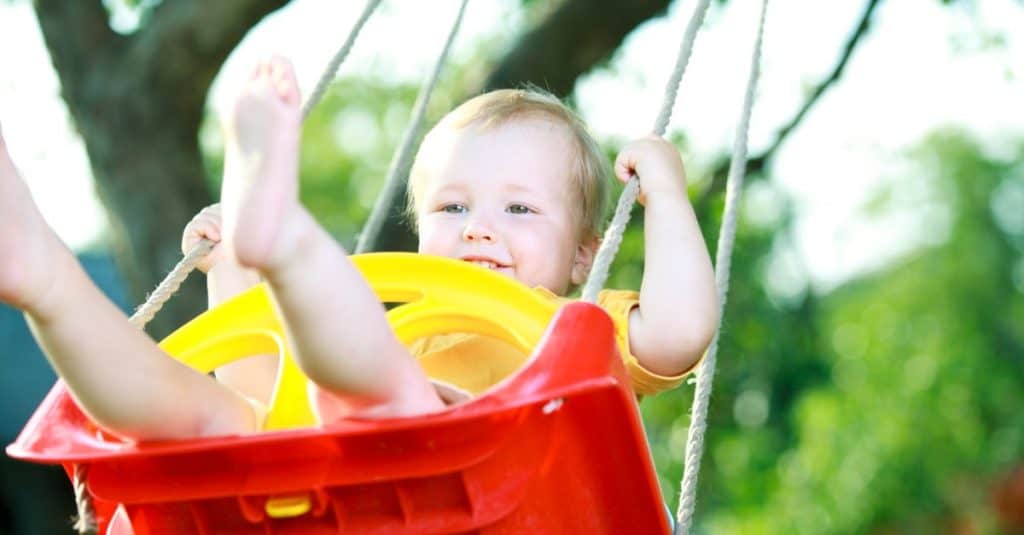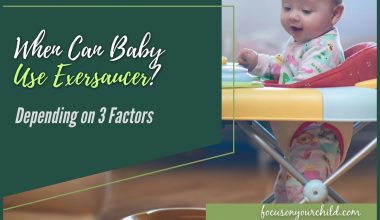With a new baby, safety is one of the biggest and most valid concerns any parent can have. A type of brain injury known as shaken baby syndrome is a common concern among parents and caregivers of infants. You may find yourself asking a question “do baby swings cause brain damage?”
The short answer is that, no, baby swings do not cause brain damage. You need not worry about brain damage when placing your baby in a swing. The amount of force a baby swing can generate isn’t enough to cause that sort of severe injury.
That being said, shaken baby syndrome is still a very real and very serious health emergency. It is important to understand it and its symptoms, as well as how it can be avoided.
What Causes Brain Damage in Infants?
While being extra cautious of your baby’s health and safety is important, babies are more resilient than most people are led to believe. Bouncing or rocking in a properly installed and used baby swing will not hurt an infant’s brain or any other part of their body for that matter.
Rough play such as tossing or swinging an infant in the air, while risky, does not usually cause SBS. Accidental falls, spills, tumbles, and bumps are also unlikely to cause SBS.
Brain damage in infants that occurs as a result of vigorous shaking is known as shaken baby syndrome (SBS) or shaken impact syndrome (SIS). It is a non-accidental injury – it is the intentional and vigorous shaking of an infant, possibly by a caregiver out of anger or frustration when a baby is excessively fussy or won’t stop crying.
There is a multitude of reasons why infants are susceptible to traumatic brain injury from being shaken in a way that older children and adults aren’t. Listed here are some of the most significant:
- Infants have a high head size to body length ratio (1:4) and underdeveloped neck muscles and ligaments, making them susceptible to whiplash injury. This is also why supporting an infant’s head and neck while carrying them is so important.
- An infant’s brain has a water content of 90% while an adult has only 75%. This makes it more gelatinous and compressible within the skull when the head flops back and forth rapidly.
- Infant brain cells do not have as much myelin, a.k.a. the fatty sheath that insulates and protects brain cells from shear stress.
- In infants, the bones making up the cranium have yet to fuse. The fontanelles or areas where the brain is not covered by bone are much more delicate.
When an infant is shaken, the rapid extension and flexion of the neck cause the brain to collide with the inner surface of the skull back and forth repeatedly. This can cause the brain to bruise and swell. The long nerve cell projections (axons) that transmit brain impulses from one cell to another can tear.
Blood vessels surrounding the brain can also rupture and bleed into the cranial cavity. Retinal hemorrhage or damage to the blood vessels in the retina which makes up the back wall of the eye is also common in SBS.
Note that while shaken baby syndrome is most common in infants less than 2 years of age, it may be diagnosed in children up to 6 years old.
Symptoms and Effects of Shaken Baby Syndrome
Shaken baby syndrome does not always manifest with immediate and obvious symptoms that are typical of other types of traumatic brain injury and SBS can go unnoticed for a period of time.
- Extreme irritability or fussiness.
- Bruising on the arms and chest.
- Lethargy and weakness.
- Vomiting and difficulty feeding.
- Bulging fontanelles.
- Apnea and/or difficulty breathing.
- Dilated pupils that do not contract in response to bright light.
In the United States, a fourth of all SBS victims die. Shaken baby syndrome almost always causes irreversible and lifelong brain damage.
Survivors of shaken baby syndrome often need long-term rehabilitative care to help them cope with neurological handicaps caused by the initial injury. Possible effects of SBS include:
- Temporary or permanent visual impairment.
- Developmental delays.
- Cognitive and motor disabilities.
- Communicative and language difficulties.
- Hearing loss.
Do Baby Swings Cause Brain Damage? (Safety Explained)

The proper use of baby swings and other baby furniture does not cause SBS. Nevertheless, it is important to learn the safety and proper use of baby swings, to keep your baby safe and prevent other forms of injury.
Of course, you want to provide your baby with nothing less than the best, most trustworthy, gear you can get your hands on. In the United States, baby swings and other baby products must be certified safe by the Consumer Product Safety Commission.
Always follow the manufacturer’s guidelines for age and weight restrictions on baby swings. An infant is more likely to get hurt if they are placed in a swing that they cannot fit properly in.
Baby swings should only be used when there is an adult around to supervise. An infant can fall into an unsafe position while strapped into a swing (tangled in the harness, limb caught in a hanging toy, etc.) and hurt themselves. An adult should be there to keep them safe at all times.
Baby swings are often used to calm infants and put them to sleep. While it is safe to use a baby swing to help lull an infant to sleep, they need to be transferred to a safe sleeping surface (i.e., firm and flat, on their back) as soon as possible.
An infant sleeping in an upright or angled position, such as that when they are in a swing or car seat, cannot reliably hold their head up. Their airway may become restricted should their head fall forward. Sudden infant death syndrome has been known to occur when infants are left to sleep in an upright position.
Avoiding Shaken Baby Syndrome
Shaken baby syndrome is a severe form of child abuse. It most frequently occurs when a caregiver holds a baby by their arms and torso and shakes them out of anger or frustration. Preventing it boils down to a caregiver understanding that shaking a baby is never okay and that lifelong damage can result from SBS.
A baby’s cry is their only mode of communication. In the first 3 months of life, a baby can cry up to 3 hours a day – that’s enough to make any new parent tense and even upset themselves. Try not to take it personally or let it get on your nerves too much.
Some babies really will cry endlessly and inconsolably – it isn’t your fault. Here are a few tips to remember when trying to soothe a crying baby:
- The essentials – Are they fed and dry? Is the room too warm or cold? Too tired or overstimulated?
- Check for signs of illness – fever, rashes, sweating, paleness, vomiting, diarrhea, etc.
- Go for a car ride or a walk in a stroller.
- Dim the lights and speak in a soft voice.
- Wrap them up in a swaddle or sleep sack.
Being the primary caregiver of a baby is one of the hardest jobs anyone can have. It is important to continue caring for yourself and managing your stress levels. Allowing yourself time to recharge and unwind is good for both you and your baby.
If you feel upset or overwhelmed to the point where you feel like you might shake or hit your baby, put them down in a safe place such as their crib. Dim the lights in the room and walk away. Check on them every 10-15 minutes or have a trusted friend, family member, or partner handle the baby while you take a break.
To sum it up, the answer to “do baby swings cause brain damage” is a NO.

